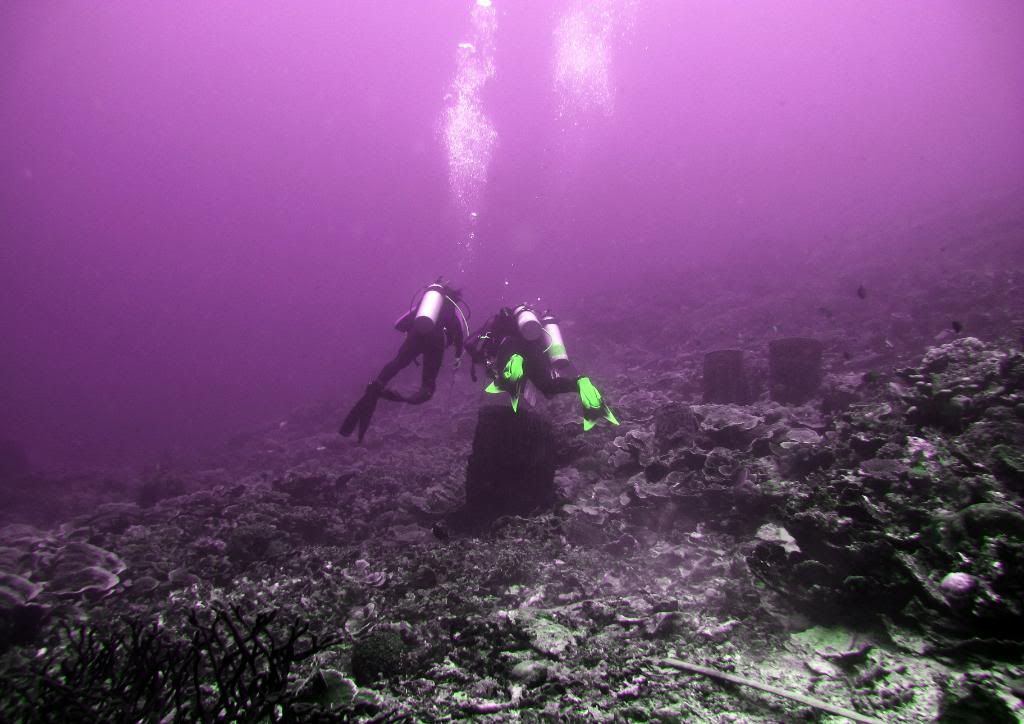On June 18th I had the opportunity to pay a second visit to the Tyrrhenian Sea. This time I did not need to catch buses and trains because my sister gave me a ride. We drove to Livorno then headed south, following a rocky coastline, to reach her favorite lido called Fortullino, where the water is more transparent and, supposedly, cleaner than the one I have experienced at Viareggio.
A narrow and curvy one-lane road cuts through this stretch of the Tuscan coast. During the summer, it is usually congested with all sorts of wheeled vehicles and their crazy drivers. Public trails steeply lead to sea. Some are definitively not suitable for scuba divers unless the diver in question is like Miguel Angel Arias

Small lidos emerge from concrete platforms or man-made sandy beaches. Old towers and modern restaurants unexpectedly appear at the end of sharp bends with breathtaking views over the blue Tyrrhenian Sea. During days without too much haze, several islands, which are part of the Arcipelago Toscano, are also visible.
At a viewpoint we parked the car and inspected the watery expanse below us sighing: a cool wind creased the surface of the sea with nervous whitecaps while mighty breakers were bashing the rocky shore without mercy. There was no way that we could go swimming at Fortullino because the entry to the water on cobblestones would have been far too dangerous.
Feeling disappointed, Nature forced us to change our plan. After driving for 10 miles further south, we reached the small town of Rosignano Solvay. The rough shoreline gradually flattened and sand replaced rocks and cliffs. As a teenager, I remember glancing at this bright strip of sand from the back seat of my family’s car while my father was driving on the highway. In those days I had no idea that decades later I would have snorkeled in the weirdest water of the entire Italian coast here.
Immersing my body at the Spiaggie Bianche (White Beaches) was like taking a bath in milk. Unfortunately, it was not the milk of asses in which ancient powerful women like Cleopatra or Poppaea Sabina (mistress and later wife of the Roman Emperor Nero) used to bathe every day to enhance their beauty. Instead, it was a concoction of seawater mixed with cooked and finely grinded limestone and calcium chloride. An industrial waste that the nearby chemical plant Solvay has been dumping into the Tyrrhenian Sea since the 1940s while manufacturing sodium hydroxide, sodium bicarbonate and sodium carbonate.
My sister reassured me that swimming in that water was not a serious health hazard. Beside, a sign warned us that swimming was not allowed on a small stretch of the beach only (where the water is always white). It was an area one hundred meters long on both sides of a channel, which Solvay uses to discharge its waste into sea, located several miles south from the sandy spot where we had laid our towels, so according to the Italian law we were ok.
However she was surprised to notice that the water was milky white right where we were supposed to swim and everywhere else along the Spiaggie Bianche. Usually, it is crystal clear and turns turquoise with the increasing depth of the sea bottom as it were a pristine tropical beach. Even the water in a nearby channel, which supplies the plant with fresh seawater, was pure white. We guessed that the northwest wind and the rough conditions of the sea were spreading the limestone and calcium chloride from the mouth of the waste channel to the whole beach.
My first attempt to snorkel in this churning whiteness failed because, perhaps, the sun blinding light and the glow from this unreal water somehow made me lose my concentration while I was wearing my fins and the waves were tossing me around. When I thought I was ready, I began to kick only to discover after few seconds that my left foot felt lighter than the right one and with dismay I discovered that I had lost one fin!
Searching for a fin in that kind of visibility that goes well below zero was like trying to find a needle in a huge haystack. In vain I tried to look for the fin with the mask and my nose glued to the bottom. I could not see even the other bathers' feet. I quickly gave up and began to walk up and down the area between the spot where I remembered I was messing with the fin last and the stretch of beach where I assumed the waves were more likely pushing the fin to. While I was using my legs and feet as ‘fin detector’ all at sudden I saw the fin emerging from that watery artificial milk. A young man was holding it in one of his hands looking rather puzzled...














